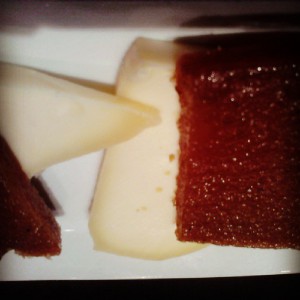How to cook carne membrillo (quince paste) Posted by Magda on Oct 27, 2014 in Spanish Culture
Aunque estamos en el veranillo de las rosas de otoño, la tercera estación del año ya está aquí llena de colores y deliciosas frutas de temporada. Aquellos que hemos tenido la suerte de tener árboles frutales en casa normalmente relacionamos cada estación con un ritual culinario distinto. Yo recuerdo de mi infancia que cada otoño se preparaba en casa un postre delicioso que duraba bastante tiempo: la carne membrillo.
¿Alguna vez habéis comido un membrillo?A alguna gente le desagrada su sabor ácido, así que lo utilizan para hacer mermelada o algún tipo de pudding. Mi favorito es el postre que ya he mencionado: la carne membrillo o dulce de membrillo. Aunque son necesarios pocos ingredientes, la preparación es un poco laboriosa, e incluso peligrosa… ya os contaré por qué.
Ingredientes:
– Membrillos (empecemos con un kilo)
– Azúcar (siempre la mitad que de fruta, así que necesitaremos medio kilo).
– Cáscara y zumo de limón.
Primero pelamos los membrillos, les quitamos el corazón y comprobamos que no tengan “visita”… ( gusanos, por ejemplo… es muy fácil que haya en el corazón).
Troceamos los membrillos y los ponemos en una olla con la cáscara de limón, cubiertos de agua. Cocemos los membrillos hasta que estén tiernos.
Quitamos el agua, trituramos la fruta, añadimos el azúcar y el zumo de limón y cocemos todo, moviendo constantemente con una cuchara de madera hasta que el azúcar se haya disuelto completamente. Tendremos que ser muy cuidadosos porque el puré puede llegar a saltar hasta el techo. Se cuece hasta que la pasta se espese y se vuelva de un tono anaranjado oscuro (sobre una hora y media más).
Entonces lo vertimos en un molde, o en platos hondos, como hacíamos en casa. Hay que dejarlo enfriar varias horas antes de probarlo.
Para comerlo, coged un trocito pequeño de carne membrillo y ponedlo sobre un trozo de queso manchego.
¡Delicioso!
 (photo by Dario Alvarez)
(photo by Dario Alvarez)
Even though we are now in the autumn roses’ summer, the third season of the year is already here full of colours and tasteful seasonal fruit. The ones who have been lucky to have fruit trees at home usually connect each season with a different cooking ritual. I remember from my childhood that every autumn we made a delicious dessert at home, which lasted quite a lot of time: carne membrillo, or quince paste.
Have you ever eaten a quince? Some people dislike its acid taste, so they use it to prepare jam or some kind of pudding. My favourite dessert is the one I mentioned before: “la carne membrillo” or quince paste. Although we need very few ingredients, the making is a bit back-breaking, and even dangerous… I´ll tell you why.
Ingredients:
-Quince (let´s start with a kilo)
-Sugar (always half of the fruit, so we will need half a kilo)
-Lemon peel and its juice.
First we peel the quinces, core them and check there aren´t unwanted “visitors” (such as worms…you can find them easily at the core).
We chop them and put the quince pieces and the lemon peel in a saucepan, covered with water. Cook them till the pieces are fork tender.
Drain the water, purée the fruit, add the sugar and the lemon juice and cook it, stirring the mixture with a wooden spoon until the sugar has completely dissolved. You´ll have to be very careful because the purée can spatter up to the ceiling. You have to cook it until the paste becomes thick and gets a dark orange color (about an hour and a half more).
Then we pour the paste into a mold, or into soup plates, as we used to do at home. You have to let it cool several hours before you taste it.
To eat, take a small slice of carne membrillo and put it on top of a slice of Manchego cheese.
¡Delicious!

Build vocabulary, practice pronunciation, and more with Transparent Language Online. Available anytime, anywhere, on any device.



